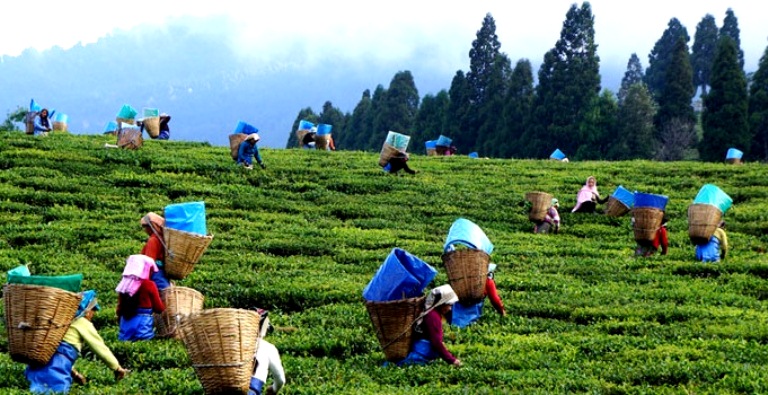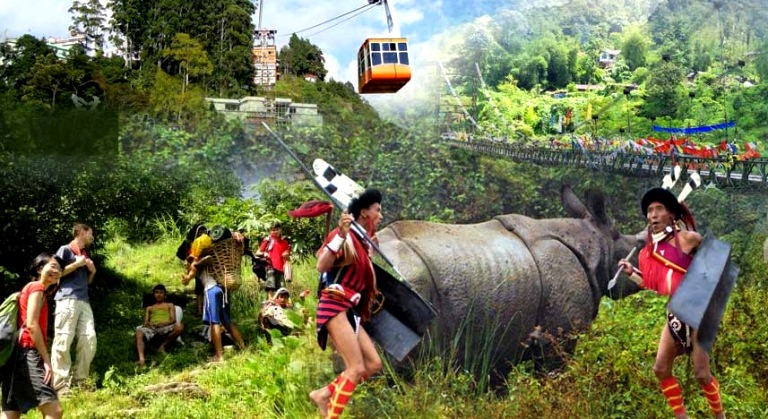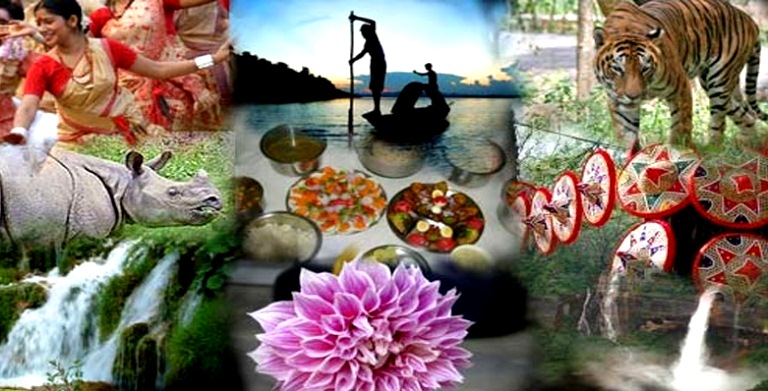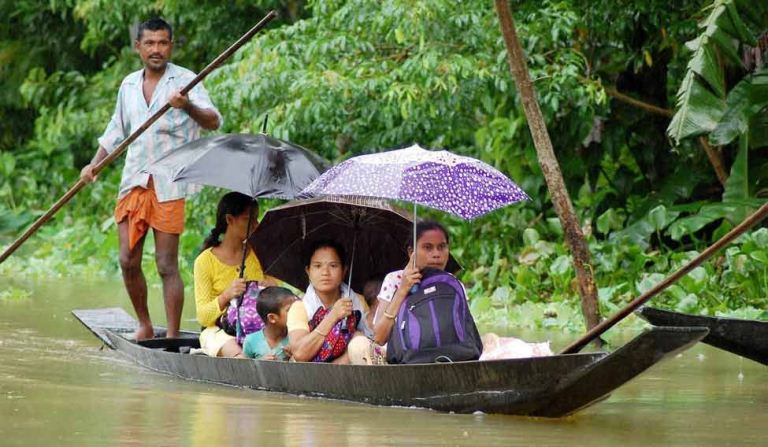
OVERVIEW- North East India with its pleasant climate, abundant scenic beauty and serene ambiance proves to be the perfect summer holiday destination. Perched away in immaculate mountains and beautiful valleys of Himalayas, Northeast India is a virgin, hypnotic and one of the most exquisite regions around the blue planet. The fascination rendered by imposing mountains, spellbinding greenery, opaque woods, exotic flora and fauna leaves the tourists with unsurpassed delight. Explore the unbeatable serenity of nature of Assam and Meghalaya. Assam Meghalaya Tour is a complete treasure for the nature lovers. Explore the natural clearing in the regions of Guwahati, Shillong, Cherrapunji, Kaziranga, Kohima, Jorhat and Majuli. The exciting mountain peaks, crystal clear lakes, breathtakingly beautiful golf courses, museums and the zoo are the key reasons why people visit this region. For its climate and unique topographical features the British North East India is regarded as the Scotland of the East.
GUWAHATI- Considered to be the gateway to North East India, Guwahati is the largest city in the region. It is situated between the southern bank of Brahmaputra River and the foothills of the Shillong plateau. Dispur, a part of Guwahati, serves as the capital of Assam. The hill ringed, green wooded, river bordered urban centre was also known as Light of East in the ancient times. Popularly also known as City of Temples as the temples are perched on hills or on hillsides which offer panoramic view of the vast Brahmaputra as well as the bustling city.
SHILLONG- Shillong is popularly known as the Scotland of the East and is famous for its picturesque rolls of hills, abundance of flora and fauna and its music culture. The Capital of Meghalaya, Shillong is one of the major tourist destinations in North East India. The British loved this place so much that they had established its Capital for Eastern Bengal and Assam.
CHERRAPUNJI- Cherrapunjee in Meghalaya is one of the wettest places on the planet and the only place in India to receive rain throughout the year. The town of Cherrapunji is nestled in the East Khasi Hills about 50 km southwest of the state's capital, Shillong. Cherrapunji, also known as Sohra or Churra, means the land of oranges. The cliffs of Cherrapunji also offer stunning views of the plains of Bangladesh.
KAZIRANGA NATIONAL PARK- Kaziranga National Park in Assam, is a UNESCO World Heritage Site which is famous worldwide for achieving success in the conservation of the one horned Indian Rhinoceros. Besides, it also provides habitat for a number of threatened species and migratory birds. The sanctuary is one of the few known habitats of one horned rhinoceros.
KOHIMA- Laidback and serene, Kohima is situated in the north eastern region of India. Capital of Nagaland, Kohima's leisurely pace of life attracts travellers to offer a relaxing environment. Kohima was built by the British and is home to the Naga and Kulkis tribe who can amaze one with their independence and a mystical and colorful culture that surrounds them.
JORHAT- Nestling on the northeastern part of Assam and along a tributary of River Brahmaputra, Jorhat is an important agricultural town for Assam. It is famous for its vast lying tea gardens and is also called the 'Tea capital of the world'. Since the time of British rule, Jorhat has been the main center for tea cultivation. Jorhat is the second major city in Assam after Guwahati and acts as a gateway to upper Assam and Nagaland.
MAJULI- The biggest river island in the world, Majuli is located on the river Brahmaputra in Assam. Majuli is a lush green environment-friendly, pristine and pollution free fresh water island, just 20 km from the Jorhat city. With a total area of 1250 sq. km, Majuli attracts tourists from all over the world. Mostly inhabited by Tribals, the culture of Majuli is unique and quite interesting and is one of the key reasons why people love this place so much. It is also called the cultural capital of Assam. The festivals celebrated here are all joyous and vibrant.
Please Note: This is just a suggested itinerary indicative of what could be possible. We tailor summer holidays vacation for your specific needs. Contact us if you want modifications so that we could tailor a holiday to suit your need for an unforgettable India summer tour.
Tour Destination: Guwahati - Shillong - Cherrapunji - Kaziranga National Park - Kohima - Jorhat - Maujili Islands- Guwahati
Travel Duration: 12 Nights/13 Days
DAY 1: GUWAHATI - SHILLONG
Welcome at Guwahati Airport. Drive to Gateway of Meghalaya- Shillong. Enroute visit
UMIAM LAKE- As per the legends, two heavenly sisters decided to make their way to Meghalaya. However, one of them had reached the destination and the other could not due to some reason. So the former could not trace out her sister and started crying with her broken heart. She cried so much that and a lake was formed with her tears. Locally known as Umiam Lake, Barapani means vast waters.
Today it becomes a hub for the water sports activities such as speed boats, sailboats and water scooters. It is enveloped by lush green East Khasi hills and offers some of the best panoramic sights for nature-lovers.
Continue your drive and later transfer to the hotel. Evening at leisure or you can go for a leisure walk around the place.
Overnight at Hotel.
DAY 2: SHILLONG
After breakfast visit Shillong, Scotland of the East
ELEPHANTA FALLS- Named after an Elephant like stone at its foot, the Elephant Falls are amongst the most popular falls in the North-East, situated next to Shillong. It is a tourists' paradise with three layers of the falls accessible to the layman from different vantage points. At Elephant Falls one can get very close to the falls and enjoy its serenity and might.
SHILLONG PEAK- Shillong peak is Meghalaya's highest peak in the Himalayas. It is at an altitude of 1965 meters above the sea level. It is the best destination for the nature lovers. It is said that the Shillong is named after this peak. The view from the peak is breathtaking as it defines the Shillong city and the view of the Himalayas.
WARDS LAKE- A pretty artificial lake surrounded by gardens is an ideal evening get away! Also known as the Polok Lake, it is usually flocked by couples, picnickers and locals. Boating and fountain dancing are big activities of this place.
GOLF COURSE- Shillong Golf Course is considered to be the "Glen-eagle of the East" at the United States Golf Association Museum. It was set in a valley at an altitude of 5200 ft in 1898 as a 9 (nine) hole course and later converted into an 18 (eighteen) hole course in 1924 by Captain Jackson and C. K. Rhodes.
MAHADEV KHOLA DHAM- Believed to be about 150 years old, the Mahadev Khola Dham is a cave temple popular with Shiva devotees. It is believed that the shiva lingam placed here was discovered by the Subedhar Major of the 8th Gurkha Rifles when he was exploring the area after he saw it in a dream.
Overnight at Hotel.
DAY 3: SHILLONG - CHERRAPUNJI - SHILLONG
Today drive to the wettest places on the planet Cherrapunji. Transfer to hotel. Later visit this beautiful place of Cherrapunji
LIVING ROOT BRIDGES- Meghalaya's double-decker and single-decker root bridges are known to be unique in the world. The bridges are tangles of massive thick roots, which have been intermingled to form a bridge that can hold several people at a time. Made of the Indian Rubber Tree this is one of the biggest attractions of Cherrapunji. A unique attraction and quite an innovative mix of nature and engineering. The Umshiang River flows beneath the bridge.
NOHKALIKAI FALLS- One of the most photogenic waterfalls in India, Nohkalikai in Meghalaya is the fifth highest waterfall in India. Nohkalikai, which means means Ka Likai's Leap in Khasi language, is located about seven km away from Cherrapunji, the second wettest place on the planet.
MAWSYNRAM- Crowned as the wettest place on earth, the village of Mawsynram is a nature lover's dream and the best place to witness the fury of the rains. With 11,872 mm of rainfall received annually, Mawsynram beats Cherrapunji by a slender margin.
SEVEN SISTERS FALL- the Seven Sisters Falls have the reputation of being the fourth highest waterfalls in India. Also known as Nohsngithiang Falls, they form a seven-segmented waterfall, which plunges over the top of limestone cliffs of the Khasi Hills. The falls only flow during the rainy season. The vibrant colors of the setting sun make for a great sight.
MAWSMAI CAVES- Mawsmai cave is one of the main tourist attractions in the Cherrapunji, which is credited as the wettest place on Earth. These magnificent caves are formed out of limestone and are quite long and deep.
KHOH RAMHAH- Also known as Motrop and the Pillar Rock, Khoh Ramhah is a massive rock formation that looks like a giant cone. In the local language, Khoh Ramhah means basket of the giant.
THANGKHARANG PARK- The Park is the house of various orchids and birds. The park offers you a panoramic view of Bangladesh and Kynrem falls cascading down at a distance in three levels. The serpentine roads add to the beauty of this place.
Later in the evening return back to Shillong.
Overnight at Hotel.
DAY 4: SHILLONG - KAZIRANGA NATIONAL PARK
Today drive to Kaziranga National Park. On the way to Kaziranga we will explore the cultural city of Tezpur visiting its magnificent scenic beauty and exquisite archaeological ruins. Transfer to hotel. Evening at leisure to enjoy wonders of nature or you can go for a leisure walk around the place.
Overnight at Hotel.
DAY 5: KAZIRANGA NATIONAL PARK
In the morning discover India's most wonderful National Park. Get ready early in the morning for wildlife viewing and nature walk in the park. Take a jungle safari in an open jeep/elephant safari in search of world famous one-horned Rhinos, tigers, elephants, jackals, swamp deer and many other species of mammals as well as a wealth birdlife.
In the afternoon go for a tribal village visit to see silk worm rearing by Assamese. Evening free for leisure.
Overnight at Hotel.
DAY 6: KAZIRANGA NATIONAL PARK
Today morning watch the birdlife of Kaziranga. Explore the eastern Range of the National Park in a jeep safari. The eastern range of Kaziranga known as Agoratoli consists mostly of woodland and is famous for its wide variety of Birds. It is home to a variety of migratory birds and is also known to have large population of Wild Elephants.
In the evening time once can also visit the nearby local village to see their way of life & livelihood.
Overnight at Hotel.
DAY 7: KAZIRANGA NATIONAL PARK - KOHIMA
Today after breakfast drive to Kohima. Transfer to the hotel. Later go on a village tour visiting
KISAMA HERITAGE VILLAGE- A village situated in the outskirts of Kohima, Kisama heritage village seeks to preserve and promote the cultural and traditions of the Naga people. Kisama heritage Village is a concerted effort on part of the Nagaland administration to revive and conserve the erstwhile tribal culture of the Naga people who have lived on these lands for millennia.
KHONOMA GREEN VILLAGE- A one of its kind project in the country, Khonoma village is a testament to the will power of the tribal groups of Nagaland to protect and conserve their natural habitat. The village is an eco-village with all forms of hunting admonished for a more sustainable ecosystem.
Evening at leisure to enjoy wonders of nature or you can go for a leisure walk around the place.
Overnight at Hotel.
DAY 8: KOHIMA
After breakfast visit Kohima
DZUKOU VALLEY & JAPFU PEAK- Located some 25 km south of Kohima, Dzukou valley and Japfu Peak offer one of the most breath taking landscapes of the continent. Nagaland is called the 'Switzerland of the East' and Dzukou valley and Japfu Peak provide solid proof to that moniker. Dzukou valley and Japfu Peak trek, is one of the most beautiful and mesmerizing treks you can find in the country and an absolute must for all trekking enthusiasts.
KOHIMA MUSEUM- Nagaland is truly an amalgamation of various tribes! The Kohima Museum portrays the traditions and culture of the many tribes of the state. The museum holds many unique artifacts related to different tribes of the region.
KOHIMA CATHEDRAL- The city of Kohima has had a really violent past and now, the city is making up for it. This cathedral too stands out in the city, providing a beacon of hope and peace.
KOHIMA WAR CEMETERY- This is, perhaps, one place in Kohima you wouldn't want to miss at all. This beautiful site is dedicated to the 10,000 Allied soldiers who lost their lives during the Japanese invasion during the World War-II.
Overnight at Hotel.
DAY 9: KOHIMA - JORHAT
After breakfast drive to Tea Capital of Assam- Jorhat . Transfer to the hotel. Later visit Tea Gardens.
TEA GARDENS- The gardens of tea are spread over the foothills of North East Himalayas. One can visualize the diligent workers puck the fresh leaves. For a better experience, you can try your hand with them. Learn tea processing at the gardens. Take a leisurely walk to villages nearby. Experience the simplicity of Assamese lives. The simple homes have hardworking affable people. Opening up their homes and hearts, interact with the folks.
Evening at leisure or you can go for a leisure walk around the place.
Overnight at Hotel.
DAY 10: JORHAT - MAJULI ISLANDS
Today drive to the World's biggest River Island and settlement of Vaishnavite monasteries- Majuli. To reach this island, you need to cross the mighty Brahmaputra on a ferry. After reaching this island, explore the natural setting of the place, take leisure walks.
Overnight at Hotel.
DAY 11: MAJULI
After breakfast visit the Biggest River Island - Majuli
KAMALABARI SATRA- One of the other famous site of the island, Kamalabari Satra, this religious site too houses significant articles related to art, culture, literature and classical studies. The North Satr, another portion of the Kamalabari Satra participates in several cultural events of satria art in various Indian cities.
GARMUR- One of the important attractions of Majuli, Garmur is among the many holy seats. Other prominent holy seats in the destination are Auniati, Daksinpath and Kamlabari. This Vaishnavite spot preserves ancient artifacts and articles, the most prominent among these being Bortop.
DHAKINPAT SATRA- This was the chief satra patronized by the Ahom Ruler. This ancient educational centre is visited by thousand of devotees all throughout the year. Rasotsava, a prime festival of Assam, is celebrated with great enthusiasm and passion here. The highlight of this festival is the performance of Rasleela on a full moon night.
AUNIATI SATRA- Famous for its Apsara and Paalnaam dance, this centre was founded by Niranjan Pathakdeva and features a wide collection of traditional Assamese utensils, jewellery and handicrafts. Old utensils, jewellery and handicrafts are also housed in the centre.
Overnight at Hotel.
DAY 12: - MAJULI - GUWAHATI
After breakfast drive to Guwahati. Transfer to the hotel. Later in the afternoon visit the temple.
KAMAKHYA TEMPLE- The Kamakhya temple is one of the most revered shrines of Shakti in India, in the form of Kamakhya. Located on the Nilachal Hills just 7km from Guwahati, the Kamakhaya temple is of great religious importance. It also holds tremendous historic and archeological significance. The shrine is one of the 51 Shakti Peethas in the country and is a part of the four most important Shakti Peethas. Kamakhya temple is the Goddess of Desire, and celebratory for the Tantrik sect of Hinduism. Followers of the Tantra Sect place their belief in Kamakshi or Kamakhya and hence this shrine holds tremendous religious, historic and archaeological significance.
EVENING CRUISE ON BRAHMAPUTRA RIVER- The Brahmaputra, also called Tsangpo-Brahmaputra, is a trans-boundary river and one of the major rivers of Asia. From its origin in southwestern Tibet as the Yarlung Zangbo River, it flows across southern Tibet to break through the Himalayas in great gorges and into Arunachal Pradesh where it is known as Dihang.
Overnight at Hotel.
DAY 13: GUWAHATI
After breakfast visit City of Temples- Guwahati
UMANANDA TEMPLE- The temple is located in the small Peacock Island amidst the mighty Brahmaputra. This quiet place of worship is named after and dedicated to Lord Shiva. The Peacock Island is the smallest inhabited riverine in the world and possibly one of the most beautiful too. The Umananda temple is nestled in the laps of this serene island whose shores are washed by the mighty Brahmaputras.
BHUVANESHWARI TEMPLE- Dedicated to Goddess Bhuvaneshwari, this white shrine perched atop a hill adjacent to the city is a major draw amongst the religious pilgrims. The temple itself provides visitors with a magnificent panoramic view of the city of Guwahati.
NAVAGRAHA TEMPLE- There is a temple on Chitrachal Hill dedicated to the nine planets, since there is a great significance attached to the nine planets in the country. The planets are believed to rule the destiny of people, hence they are regarded as gods and worshipped.
SRIMANTA SHANKARDEVA KALASHETRA- It is the largest repository of Northeast India's culture. Built in the 1990s, the artistic excellence of Assam and rest of the north-eastern region is displayed here. It includes a cultural museum, library and various facilities for preserving, demonstrating and performing cultural items, besides a children's park.
ASSAM ZOO- The proud possessors of some rare and endangered species, the Assam Zoo spread over 130 acres of land is a major tourist attraction. The whiter tigers, one horned rhinos, Swamp tapirs and leopards to name a few, are usually the tourists' favorites.
In the evening depart at airport/station to catch your flight/train towards onward destination.
Distance & Time (Approx)
- Guwahati - Shillong: 100 kms/03 hrs
- Shillong - Cherrapunji: 60 kms/02 hrs
- Shillong - Kaziranga National Park: 260 kms/07 hrs
- Kaziranga - Kohima: 240 kms/07 hts
- Kohima - Jorhat: 200 kms/07 hrs
- Jorhat - Maujili Island: 50 kms/02 hrs
- Maujili Islands - Guwahati: 350 kms/08 hrs
Guwahati at a Glance
- Population: 957,352
- Area: 215 sq km
- Geo Location: Assam (North East India)
- Average Climate: 20°C - 32°C
- Best Time to Visit: October - April
- STD Code: 0361
- Airport: Guwahati Airport
Shillong at a Glance
- Population: 143,229
- Area: 64.36 sq km
- Geo Location: Meghalaya (North East India)
- Average Climate: 21°C - 32°C
- Best Time to Visit: September - May
- STD Code: 0364
- Airport: Shillong Airport
Cherrapunji at a Glance
- Population: 14,816
- Area: NA
- Geo Location: Meghalaya (North East India)
- Average Climate: 12°C - 18°C
- Best Time to Visit: October - May
- STD Code: 03637
Kaziranga at a Glance
- Population: NA
- Area: 430 sq kms
- Geo Location: Assam (North East India)
- Average Climate: 5°C - 30°C
- Best Time to Visit: November - April
Kohima at a Glance
- Population: 99,039
- Area: 20 sq km
- Geo Location: Nagaland (North East India)
- Average Climate: 17.8°C
- Best Time to Visit: October - May
- STD Code: 0370
Jorhat at a Glance
- Population: 219,565
- Area: 106.7 sq km
- Geo Location: Assam (North East India)
- Average Climate: 7°C - 24°C
- Best Time to Visit: October - March
- STD Code: 0376
- Airport: Jorhat Airport
Majuli at a Glance
- Population: 167,304
- Area: 352 sq km
- Geo Location: Assam (North East India)
- Average Climate: NA
- Best Time to Visit: October - March
Need Aspark Help?
For Tour Packages, Vehicle Rental and Customer Care Support.
+91 9999 31 7846
booking@asparkholidays.comWhy Travel with Us?

Excellent Support
Our Team Available 24x7 for Customer support
Best Price & Savings
We Offer the Most Competitive Prices.
.jpg)




